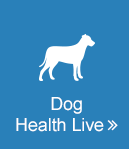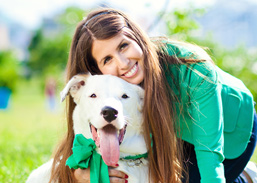Cancer. One very powerful word that can evoke feelings of fear, pain, triumph and loss. Nearly every person’s life has been in touched by cancer in one way or another and our dogs & cats are no different. The incidence of cancer in dogs is about the same of that in people. Cats are less likely to develop cancer, but when they do it is often more severe. The most obvious signs of cancer are swollen lymph nodes and growing / changing lumps, but cancer can emerge in many forms. Other chronic warning signs that can be overlooked as your pet ‘just not feeling well’ include lethargy, weight loss, vomiting and diarrhea, coughing, limping, swelling, difficulty urinating, oral odor or a wound that doesn’t heal. An enlarged abdomen could be a sign of a growing mass inside the pet’s body and unexplained bleeding from the mouth or nose could mean a tumor in the head. These symptoms do not necessarily mean your pet has cancer, but you should still mention them to your veterinarian to be sure.
Biology of Cancer
All tissues in the body are made of cells. Tissues are continuously broken down, repaired and rebuilt with new cells. The code for cell production is written into our DNA inside the nucleus of all cells. Sometimes errors can occur in the DNA that cue the body to produce too many cells. Usually these errors are minor and the excess cells produced are normal causing a benign tumor. Cancer is the uncontrolled growth of abnormal cells. It develops when DNA is damaged enough to reproduce incorrectly. It can be localized or it can spread (metastasize) to nearby tissue or even go on to grow throughout the body. Metastatic tumors require lots of blood vessels to fuel the rapidly growing and spreading cell growth.
Type Description Appearance
Papilloma benign skin tumor cauliflower-like warts
Lipoma benign fatty tumor soft & squishy to the touch
Mast Cell Tumors localized skin cancer oval, firm, slightly raised dark spots
Lymphoma tumor of the lymph nodes solid growths, enlarged lymph nodes
Leukemia tumor of white blood cells (freely circulating in the blood)
Basal Cell Carcinoma skin cancer open sore, red patches, shiny bumps
Squamous Cell Carcinoma skin or organ lining cancer open sore, scaly red patches, warts
Sarcoma tumor of connective tissue you may not be able to feel it
Osteosarcoma tumor of the bone hard lump on growth plate of bones
Mammary Gland Tumors breast cancer firm lump under the skin
Injection-Site Sarcoma tumor from vaccine firm lump where vaccines are given
What causes Cancer?
Environment
Dogs and cats live in our homes and are thus exposed to the same carcinogenic materials as us so they can develop cancer for many of the same reasons. Environmental toxins, second-hand cigarette smoke, radiation, UV rays, pollutants, viral infections, trauma, stress, artificial chemicals found in food, exercise and even digestion can cause normal atoms or molecules to lose electrons. This change to the molecular structure creates a highly reactive molecule called a free radical. Free radicals within the body usually contain oxygen atoms so another name for free radicals is “reactive oxygen species”. Free radicals are looking to steal electrons from other molecules so they can easily create a domino effect of molecules stealing electrons creating more free radicals. Everyone has some free radicals in their bodies, but when toxins create too many free radicals they can damage cell membranes, cell proteins and even DNA. Once the DNA is damaged it can begin to replicate the error which could trigger abnormal cell growth – cancer.
Genetics
Purebred animals tend to have a higher hereditary predisposition toward different types of cancers because they have been bred by people to promote certain physical traits, which limits genetic variability. Once you start selecting for a specific look, it becomes easy for genetic mutations to pop up within a bloodline. Mutts have a bigger gene pool so they are less likely to have hereditary mutations, but they are still at risk from environmental causes.
What can I do if I think my pet has Cancer?
Any time you have concerns about your pets’ health you should always see your vet because they know your animal’s individual history and have the tools to make a diagnosis & treatment plan. Your vet will want to perform a thorough physical exam, do blood tests and probably take radiographs (x-rays) or do an ultrasound. In order to confirm the diagnosis of cancer, a biopsy will need to be done. A biopsy is a minor surgical procedure where the vet removes a small tissue sample so it can be tested by the lab to see if cancer is present and, if so, determine the severity. Because there are so many different types of cancer, the treatments can vary too. Your vet will assess your animal and determine if surgery, chemotherapy, radiation or immunotherapy are right for your animal. Severe cases may be referred to a veterinary oncologist (a vet that specializes in treating cancer). When detected and treated early you have a much better chance of beating it! Today’s advances in both human and veterinary medicine can provide some form of benefit to nearly any patient and more than half can be cured completely.
How do Cancer Nutraceuticals work?
Most cancer patients require a comprehensive treatment plan that includes pharmaceutical therapies and surgery, but more than half of pet parents are now asking their vet for complementary / natural medical options when faced with serious health problems.
Antioxidants
Commonly referred to as “free radical scavengers”, antioxidants are natural chemicals that neutralize free radicals by providing extra electrons. The body makes many of its own antioxidants, but additional support comes from the diet. Studies on antioxidants and humans with cancer have yielded mixed results and there is not a strong body of evidence supporting their efficacy in treating cancer, but the trials tend to use purified substances as opposed to fresh fruits, vegetables and grains that are naturally rich in antioxidants. All antioxidants are different and work differently when they interact with free radicals so the best results come from giving your pet a variety of antioxidants. The National Institutes of Health created a unit of measuring antioxidant activity called the ORAC (Oxygen Radical Absorbance Capacity). This value is often listed on antioxidant supplement labels so you can see how potent they are.
Examples of Antioxidants:
- Beta-carotene – Lycopene
- Vitamin A – Grape Seed Extract
- Vitamin C – Apricot Pits
- Vitamin E – Dimethylglycine (DMG)
- Alpha Lipoic Acid (dog only) – Resveratrol
- Pycnogenol – Glutathione
- Coenzyme Q10 – Flavonoids
- Polyphenols – Astaxanthin
- Super Oxide Dismutase (SOD) – Catalase (CAT)
- Omega 3 Fatty Acids – Epigallocatechin-3-gallate (EGCG)
Fresh foods like blueberries, sweet potatoes, nuts, beans, dark green vegetables and many herbs are excellent sources of antioxidants.
Consult with your veterinarian before giving antioxidants to a dog or cat that is already being treated for cancer because some supplements can interact with drugs, making them less effective.
Shark Cartilage
The skeletons of sharks are made up of cartilage, which is a flexible but strong connective tissue. Researchers have observed that sharks do not tend to have problems with cancer and believe the reason for that is the protein in their cartilage that inhibits the development of new blood vessels. Cancerous tumors require a big blood supply so slowing the body’s development of blood vessels to the tumor would restrict its nutrient supply. The study of “anti-angiogenesis” (the inhibition of blood vessel development) is getting more attention from cancer researchers, but the jury is still out on whether or not shark cartilage is truly effective.
Vitamin D
Vitamin D3 acts more like a hormone than a vitamin because it helps to activate immune system lymphocytes. It is essential to the endocrine system because it helps control cell growth, cell differentiation, synthesis of enzymes and repair of DNA. Studies show that individuals deficient in vitamin D3 have a higher risk for cancer. New evidence is showing that it may even help shrink tumors by killing cancer cells and repairing tissues.
Curcumin
A compound in the spice, turmeric, curcumin is thought to have multiple cancer-fighting abilities. It works by binding a protein that helps cancer grow and spread. Curcumin also interferes with inflammatory molecules that can cause cancer. Combining curcumin supplements with traditional chemotherapy can make cancerous cells more vulnerable to the drugs. Oral supplementation is not always well absorbed, but new treatment options are currently being studied.
Mushrooms
Many mushrooms including shiitake, maitake and reishi have been found to be high in alpha and beta glucans, which help modulate the immune system. Many mushrooms have been found to slow growth and kill cancer cells. Reishi and maitake mushrooms in particular have been studied for their ability to protect the body from chemotherapy side effects including hair loss, pain and nausea. Mushrooms have a long history of use in Traditional Chinese Medicine, but were used by the ancient Egyptians even earlier. Laboratory studies are looking optimistic, but more research is needed in living people and animals confirm that mushrooms taken orally really kill cancer cells.
Transfer Factors
Nutrients isolated from dairy and egg yolks called transfer factors have been found to support the immune system through modulation (regulating the immune response up or down depending on the animal’s condition). Transfer factors help the immune cells recognize and respond to pathogens more efficiently by increasing communication between the cells.
While more research needs to be done to come to a stronger conclusion on these nutrients’ roles in cancer-fighting health, it is clear that there are many pathways that can benefit from good nutrition. Many of the actions these supplements theoretically take can be extrapolated into new treatments to help improve the lives of pets and the people who love them.
Studies
Animal models and therapeutic molecular targets of cancer: utility and limitations.
The changing global distribution and prevalence of canine transmissible venereal tumour.
The immunosignature of canine lymphoma: characterization and diagnostic application.
Adoptive T-cell therapy improves treatment of canine non-Hodgkin lymphoma post chemotherapy.
Differential effects of selenium on normal and neoplastic canine mammary cells.
Clinical trials of immunogene therapy for spontaneous tumors in companion animals.
Role of vitamins, minerals and supplements in the prevention and management of prostate cancer.
Modulation of prostate cancer genetic risk by omega-3 and omega-6 fatty acids.
(n-3) Fatty acids and cancer therapy.
Clinical trials of vitamin and mineral supplements for cancer prevention.
Natural products for cancer prevention.
Use of nutraceuticals for prevention and treatment of cancer.
Vitamin C effect on mitoxantrone-induced cytotoxicity in human breast cancer cell lines.
Lycopene – antioxidant with radioprotective and anticancer properties. A review.
Status of oxidative stress and antioxidant levels in smokers with breast cancer from western Nepal.
The challenge of rational development of complex natural products as cancer therapeutics.
Complementary and alternative medicine use among long-term survivors: a pilot study.
Angiogenic inhibitor protein fractions derived from shark cartilage.
A novel polypeptide from shark cartilage with potent anti-angiogenic activity.
Shark cartilage as source of antiangiogenic compounds: from basic to clinical research.
Health outcomes of vitamin D part II role in prevention of diseases.
Hybrid curcumin compounds: a new strategy for cancer treatment.


